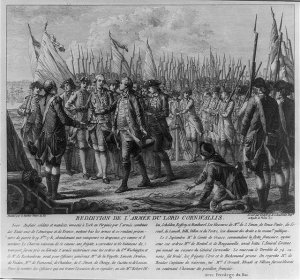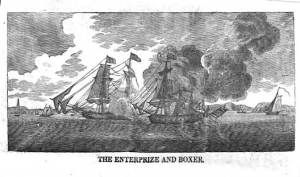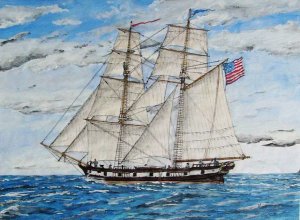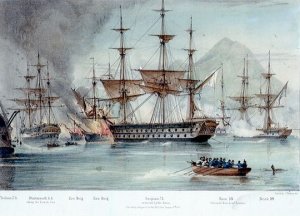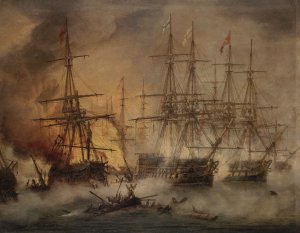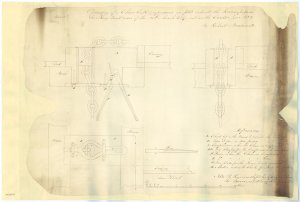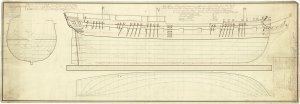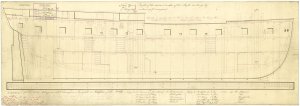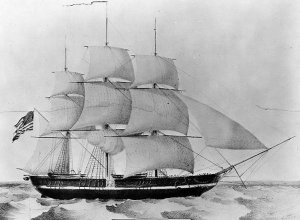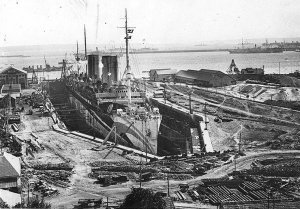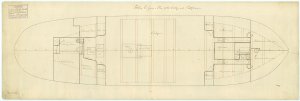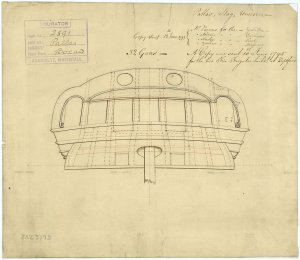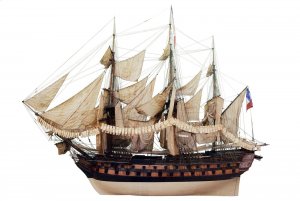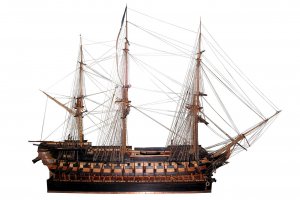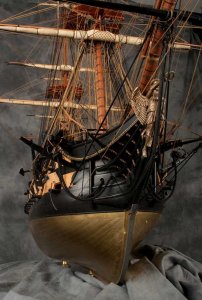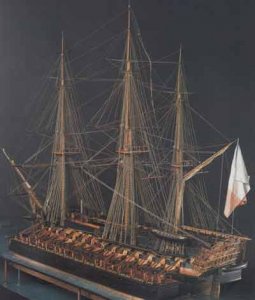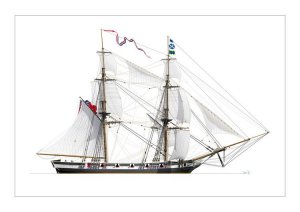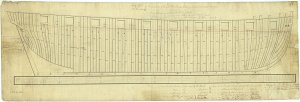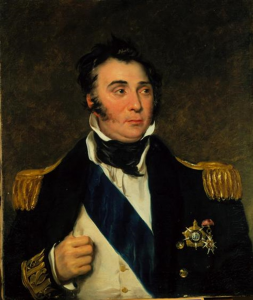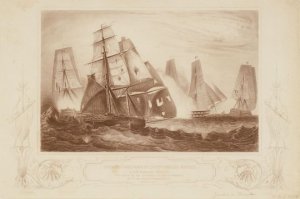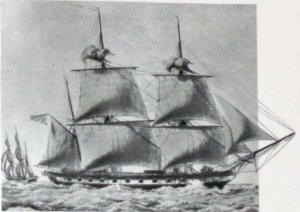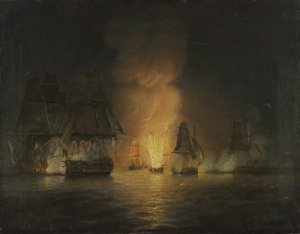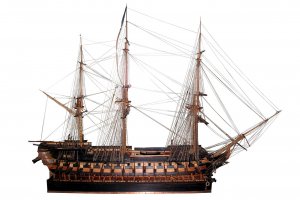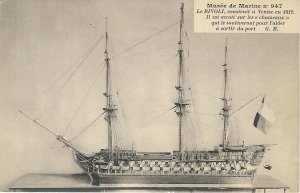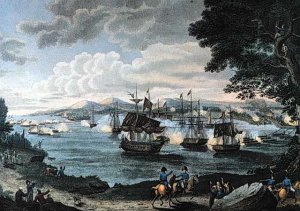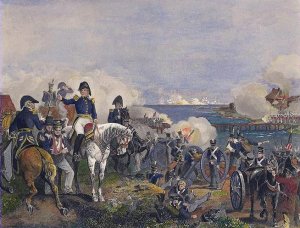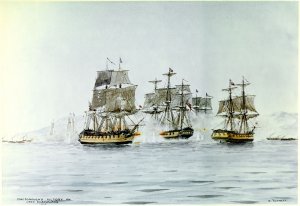Today in Naval History - Naval / Maritime Events in History
4 September 1782 - Action of 4 September 1782 - HMS Rainbow (44) took French frigate Hebe (40) off the Ile de Bas.
The Action of 4 September 1782 was a small naval engagement which was fought off the Île de Batz between a French naval frigate Hébé and a Royal Naval frigate HMS Rainbow. This battle was notable as the first proper use of a carronade and so effective was this weapon that the French commander promptly surrendered just after the first broadside.
Action
On 4 September the 44 gun frigate HMS Rainbow under Captain Henry Trollope armed entirely with carronades was off the French coast near the Île de Batz when a frigate was sighted. Having then chased the vessel it turned to be a French frigate Hébé . Hébé of 1,063 tons was a new ship of the class of the same name whose armament consisted of 38 guns, twenty six of which were 18-pounder long guns. It was commanded by the Chevalier de Vigny (uncle of Alfred de Vigny) and had on board 360 men. Hébé had left Saint-Malo on 3 September and was heading to Brest escorting a small convoy.
At 7 am, having arrived within gunshot of the French ship, the Rainbow commenced firing 32-pounder chase guns from the forecastle, which were returned by the frigate. One thirty-two pound ball shot away Hébé's wheel and killed her second captain.
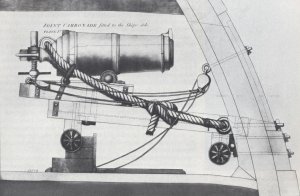
Schematics of a Carronade
Vigny examined the fragments of the hollow carronade shot and concluded that if she was firing 32-pounders as chase pieces she was actually a ship of the line in disguise. He fired one broadside, "pour l'honneur du pavillon,” (the honour of the flag) and struck his colours. The surrender of Hébé after slight resistance was not surprising taking into consideration the advantage provided by the unusual armament of the Rainbow.
Rainbow lost only one man killed and two slightly wounded. The French lost five killed, including the second captain Yves-Gabriel Calloët de Lanidy, and several wounded out of a crew of 360 men.
Consequences
A council of war was met at Morlaix whereby the loss of a new frigate, with barely a fight, condemned Vigny to fifteen years in prison, the case of his rank and service being declared as unfit for service. The captured ship was immediately integrated into the Royal Navy as HMS Hebe. After being renamed HMS Blonde in 1805 it was finally broken up in 1811.
More importantly for the Navy, Hebe would serve as a model for a new series of British frigates, the Leda class, the first of which was launched in 1800. The new class would include HMS Surprise (1812), HMS Trincomalee (1817), HMS Unicorn (1824), and a second HMS Hebe (1826).
The ships:
Hébé was a 38-gun of the French Navy, lead ship of the Hébé-class frigate.

Proserpine, sister-ship of Hébé
French Navy career
Soon after her commissioning under Captain de Vigny, Hébé was tasked to escort a convoy from Saint Malo to Brest and protect shipping from the depredations of the British Royal Navy in the context of the Anglo-French War.
In the Action of 4 September 1782, she was chased by the frigate HMS Rainbow, whose 32-pounder chase guns shot away her wheel and mortally wounded her second captain Yves-Gabriel Calloët de Lanidy. The weight of the ball made de Vigny mistake Rainbow for a disguised ship of the line. Even though the first shots had shown that Rainbow 's guns had a shorter range than Hébé's stern chasers, de Vigny never altered his course to take advantage of the longer range of his guns by firing back a full broadside. Later in the morning, the foremast of Hébé was seriously damaged and another man killed. An hour and a half later, when Rainbow was about to comme alongside, de Vigny could only fire his four of five most rear port guns and immediately struck his colours.
British Royal Navy career
The Royal Navy took Hébé into service first as HMS Hebe.
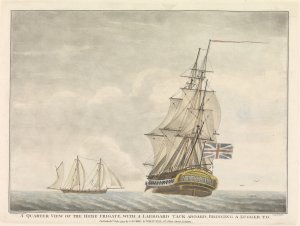
Port-quarter view of the Hebe (right) on a larboard (port) tack, with a starboard-broadside view of the lugger (left). 'HEBE' is inscribed on the upper counter on the stern of the ship. Hand-coloured.; Technique includes roulette work.
Read more at http://collections.rmg.co.uk/collections/objects/102796.html#r339HRYBaTwmf0M7.99
On 3 July 1795 Melampus and Hebe intercepted a convoy of 13 vessels off St Malo. Melampus captured an armed brig and Hebe captured six merchant vessels: Maria Louisa, Abeille. Bon Foi, Patrouille, Eleonore, and Pecheur. The brig of war was armed with four 24-pounders and had a crew of 60 men. Later she was identified as the 4-gun Vésuve. The convoy had been on its way from Île-de-Bréhat to Brest. Seaflower, Daphne and the cutter Sprightly shared in the prize and head money. The Royal Navy took Vésuve into service as HMS Vesuve.
On 24 December 1805, the Navy renamed Hebe HMS Blonde.
On 15 August 1807, Blonde, Captain Volant Vashon Ballard, captured Dame Villaret after a chase of 13 hours. She was armed with an 18-pounder gun and four 9-pounder carronades, and had a crew of 69 men. She had been out twenty days but had taken no prizes.
Fate
The Royal Navy paid off Blonde in July 1810. She was eventually broken up at Deptford in June 1811
HMS Rainbow (1747) was a 44-gun fifth rate launched in 1747. She was used as a troopship from 1776, then equipped experimentally with carronades she captured the French frigate Hébé off the coast of Brittany in 1782, was on harbour service from 1784 and was sold in 1802.

Scale: 1: 48. Plan showing the body plan with stern board outline, inboard profile (no waterlines), and longitudinal half-breadth for Rainbow (1747), a 1745 Establishment 44-gun Fifth Rate, two-decker, as taken off at Woolwich Dockyard on 14 August 1770. Rainbow was at Woolwich for a Great Repair and fitting between July 1769 and October 1770. The plan includes a table of the mast and yard dimensions.
Read more at http://collections.rmg.co.uk/collections/objects/81858.html#hgLzYEPUotlwsAZt.99

Scale: 1:96. Plan showing the roundhouse, quarterdeck and forecastle, upper deck, lower deck, and orlop deck with fore & aft platforms for Rainbow (1747), a 1745 Establishment 44-gun Fifth Rate, two-decker, as taken off at Woolwich Dockyard on 14 August 1770. Rainbow was at Woolwich for a Great Repair and fitting between July 1769 and October 1770.
https://en.wikipedia.org/wiki/Action_of_4_September_1782
https://en.wikipedia.org/wiki/French_frigate_Hébé_(1782)
4 September 1782 - Action of 4 September 1782 - HMS Rainbow (44) took French frigate Hebe (40) off the Ile de Bas.
The Action of 4 September 1782 was a small naval engagement which was fought off the Île de Batz between a French naval frigate Hébé and a Royal Naval frigate HMS Rainbow. This battle was notable as the first proper use of a carronade and so effective was this weapon that the French commander promptly surrendered just after the first broadside.
Action
On 4 September the 44 gun frigate HMS Rainbow under Captain Henry Trollope armed entirely with carronades was off the French coast near the Île de Batz when a frigate was sighted. Having then chased the vessel it turned to be a French frigate Hébé . Hébé of 1,063 tons was a new ship of the class of the same name whose armament consisted of 38 guns, twenty six of which were 18-pounder long guns. It was commanded by the Chevalier de Vigny (uncle of Alfred de Vigny) and had on board 360 men. Hébé had left Saint-Malo on 3 September and was heading to Brest escorting a small convoy.
At 7 am, having arrived within gunshot of the French ship, the Rainbow commenced firing 32-pounder chase guns from the forecastle, which were returned by the frigate. One thirty-two pound ball shot away Hébé's wheel and killed her second captain.

Schematics of a Carronade
Vigny examined the fragments of the hollow carronade shot and concluded that if she was firing 32-pounders as chase pieces she was actually a ship of the line in disguise. He fired one broadside, "pour l'honneur du pavillon,” (the honour of the flag) and struck his colours. The surrender of Hébé after slight resistance was not surprising taking into consideration the advantage provided by the unusual armament of the Rainbow.
Rainbow lost only one man killed and two slightly wounded. The French lost five killed, including the second captain Yves-Gabriel Calloët de Lanidy, and several wounded out of a crew of 360 men.
Consequences
A council of war was met at Morlaix whereby the loss of a new frigate, with barely a fight, condemned Vigny to fifteen years in prison, the case of his rank and service being declared as unfit for service. The captured ship was immediately integrated into the Royal Navy as HMS Hebe. After being renamed HMS Blonde in 1805 it was finally broken up in 1811.
More importantly for the Navy, Hebe would serve as a model for a new series of British frigates, the Leda class, the first of which was launched in 1800. The new class would include HMS Surprise (1812), HMS Trincomalee (1817), HMS Unicorn (1824), and a second HMS Hebe (1826).
The ships:
Hébé was a 38-gun of the French Navy, lead ship of the Hébé-class frigate.

Proserpine, sister-ship of Hébé
French Navy career
Soon after her commissioning under Captain de Vigny, Hébé was tasked to escort a convoy from Saint Malo to Brest and protect shipping from the depredations of the British Royal Navy in the context of the Anglo-French War.
In the Action of 4 September 1782, she was chased by the frigate HMS Rainbow, whose 32-pounder chase guns shot away her wheel and mortally wounded her second captain Yves-Gabriel Calloët de Lanidy. The weight of the ball made de Vigny mistake Rainbow for a disguised ship of the line. Even though the first shots had shown that Rainbow 's guns had a shorter range than Hébé's stern chasers, de Vigny never altered his course to take advantage of the longer range of his guns by firing back a full broadside. Later in the morning, the foremast of Hébé was seriously damaged and another man killed. An hour and a half later, when Rainbow was about to comme alongside, de Vigny could only fire his four of five most rear port guns and immediately struck his colours.
British Royal Navy career
The Royal Navy took Hébé into service first as HMS Hebe.

Port-quarter view of the Hebe (right) on a larboard (port) tack, with a starboard-broadside view of the lugger (left). 'HEBE' is inscribed on the upper counter on the stern of the ship. Hand-coloured.; Technique includes roulette work.
Read more at http://collections.rmg.co.uk/collections/objects/102796.html#r339HRYBaTwmf0M7.99
On 3 July 1795 Melampus and Hebe intercepted a convoy of 13 vessels off St Malo. Melampus captured an armed brig and Hebe captured six merchant vessels: Maria Louisa, Abeille. Bon Foi, Patrouille, Eleonore, and Pecheur. The brig of war was armed with four 24-pounders and had a crew of 60 men. Later she was identified as the 4-gun Vésuve. The convoy had been on its way from Île-de-Bréhat to Brest. Seaflower, Daphne and the cutter Sprightly shared in the prize and head money. The Royal Navy took Vésuve into service as HMS Vesuve.
On 24 December 1805, the Navy renamed Hebe HMS Blonde.
On 15 August 1807, Blonde, Captain Volant Vashon Ballard, captured Dame Villaret after a chase of 13 hours. She was armed with an 18-pounder gun and four 9-pounder carronades, and had a crew of 69 men. She had been out twenty days but had taken no prizes.
Fate
The Royal Navy paid off Blonde in July 1810. She was eventually broken up at Deptford in June 1811
HMS Rainbow (1747) was a 44-gun fifth rate launched in 1747. She was used as a troopship from 1776, then equipped experimentally with carronades she captured the French frigate Hébé off the coast of Brittany in 1782, was on harbour service from 1784 and was sold in 1802.

Scale: 1: 48. Plan showing the body plan with stern board outline, inboard profile (no waterlines), and longitudinal half-breadth for Rainbow (1747), a 1745 Establishment 44-gun Fifth Rate, two-decker, as taken off at Woolwich Dockyard on 14 August 1770. Rainbow was at Woolwich for a Great Repair and fitting between July 1769 and October 1770. The plan includes a table of the mast and yard dimensions.
Read more at http://collections.rmg.co.uk/collections/objects/81858.html#hgLzYEPUotlwsAZt.99

Scale: 1:96. Plan showing the roundhouse, quarterdeck and forecastle, upper deck, lower deck, and orlop deck with fore & aft platforms for Rainbow (1747), a 1745 Establishment 44-gun Fifth Rate, two-decker, as taken off at Woolwich Dockyard on 14 August 1770. Rainbow was at Woolwich for a Great Repair and fitting between July 1769 and October 1770.
https://en.wikipedia.org/wiki/Action_of_4_September_1782
https://en.wikipedia.org/wiki/French_frigate_Hébé_(1782)




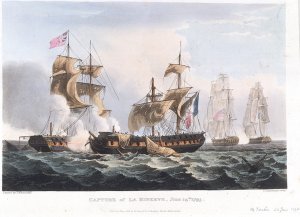
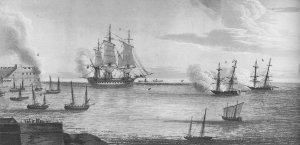


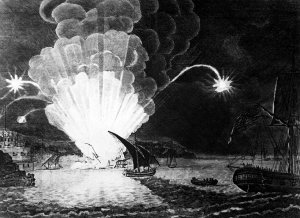
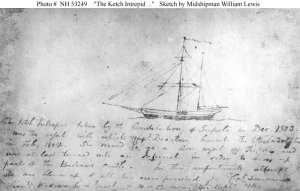
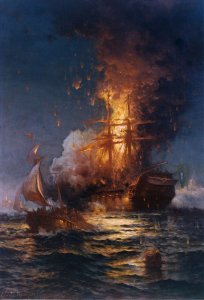
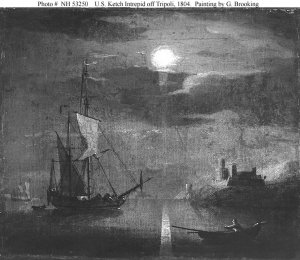
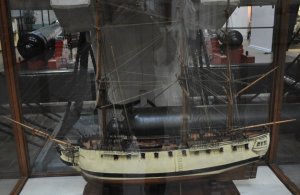

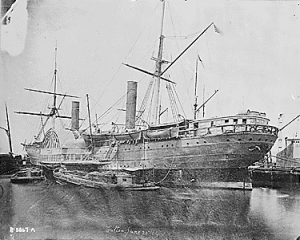


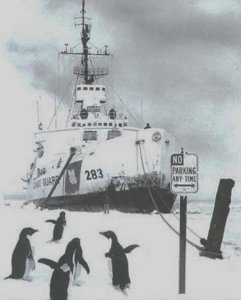




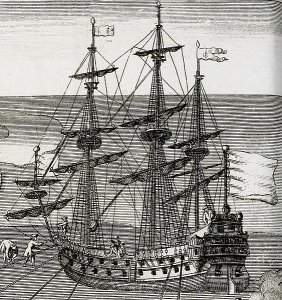



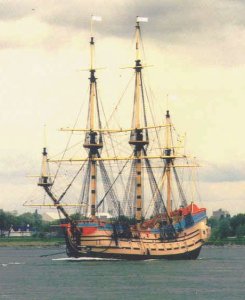
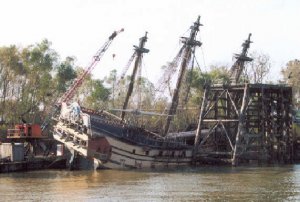
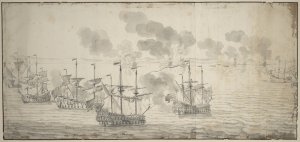

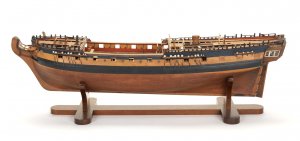
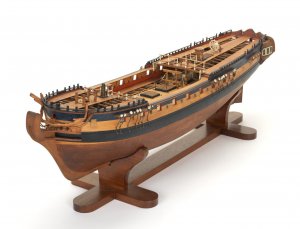
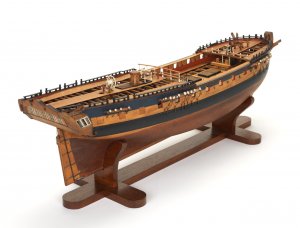
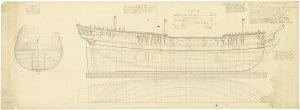
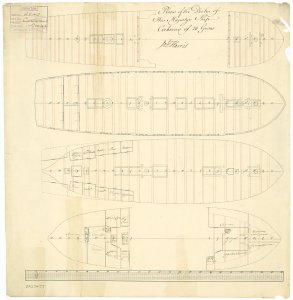

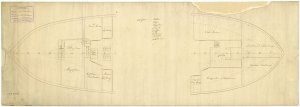
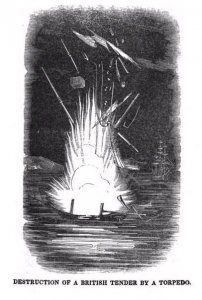
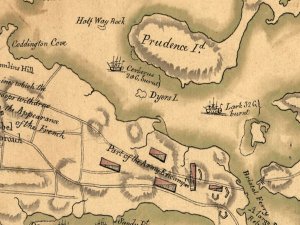
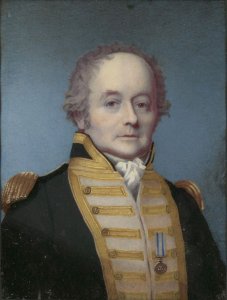
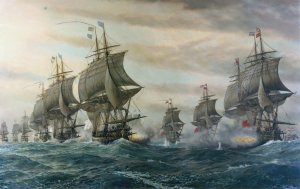


 of Barras' departure led the British to realize that the Chesapeake was the probable target of the French fleets. By 31 August, Graves had moved his five ships of the line out of New York harbor to meet with Hood's force. Taking command of the combined fleet, now 19 ships, Graves sailed south, and arrived at the mouth of the Chesapeake on 5 September. His progress was slow; the poor condition of some of the West Indies ships (contrary to claims by Admiral Hood that his fleet was fit for a month of service) necessitated repairs en route. Graves was also concerned about some ships in his own fleet; Europe in particular had difficulty manoeuvring.
of Barras' departure led the British to realize that the Chesapeake was the probable target of the French fleets. By 31 August, Graves had moved his five ships of the line out of New York harbor to meet with Hood's force. Taking command of the combined fleet, now 19 ships, Graves sailed south, and arrived at the mouth of the Chesapeake on 5 September. His progress was slow; the poor condition of some of the West Indies ships (contrary to claims by Admiral Hood that his fleet was fit for a month of service) necessitated repairs en route. Graves was also concerned about some ships in his own fleet; Europe in particular had difficulty manoeuvring.
